4. Blister

We had this special made mode for our blister, which was first cut half done by machine and then we hand sawed the middle part out. At last, we used the electrical sander to make the edge smooth, in order to prepare for making blister. What I did was basically use the pointed head hammer strike the edge of the water drop inwards the mode. Then use the round head side to concave that shape in more. The process was pretty similar as how we made the bowl. The difference is we needed to define the edge of water drop more clearly, so I put a pointed head hammer right against the edge and use another round head one to strike it, which can make the force goes more evenly into the sheet. This is how it looked like out of the mode. I used the English wheel to make the curved surface smooth, which is the same process as what I did in the first blog of making bowl. The result is looking good. I like this one the most out of the 4 pieces I have made.😜 The other piec...


